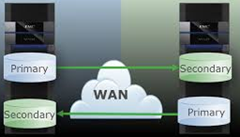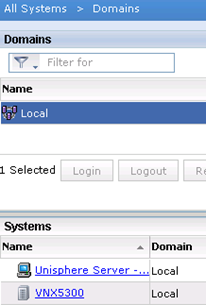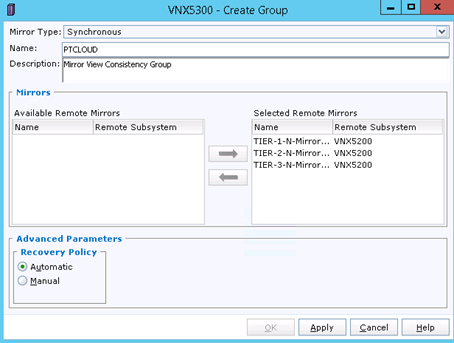By building their own Disaster Recovery solutions often reach for solutions based on data replication between storage arrays. One such solution (let us add that the cheapest) is EMC MirrorView. It is a very simple and easy to set up service fully cooperating with VMware Site Recovery Manager (SRM). LUN replication can be done synchronously or asynchronously, in the framework of assimilation theory and terminology refer you to the StorageFreak blog where colleague Tomek exactly everything described. We will focus on MirrorView configuration directly on the VNX arrays, in my case are VNX 5200 and VNX 5300.
As part of preparations create connection through SAN between arrays. We combine ports described as MirroView, Port A-0 SPA in the first array to the port A-0 SPA on second array (and correspondingly SPB). Ports which will take place in replication can not be used in the hosts Storage Groups. If you are used these ports to communicate with the hosts, remove them from the Storage Group before connecting arrays (otherwise awaits us restart SP controllers and a lot of nasty messages).
After the storage connected, verify if seen correctly, go to the section Hosts -> Initiators.
As you can see, the connection is set up correctly. To be able to perform Mirror operations, both arrays must know about yourself, be in the same domain or in two different Domains (local and remote).
This operation is carried out with a newer storage or higher-numbered firmware, in my case from the VNX 5200 I add VNX 5300 (the other way it will not work).
At this point, I have in VNX 5200 two domains, Local and Remote, for VNX 5300 is only the Local domain.
From the VNX 5200 can be managed simultaneously by both arrays seamlessly switching between them at the Unisphere client level.
Next, if you have not already have, we will create LUN for “write intent logs’. This log will help in reversing the array of problems that might occur during replication (something like transaction log). Sam LUN does not have to be big, the minimum requirement is 2GB, but we can not create it as part of Pool, this must be a RAID group. Additionally, these logs must be two, one for each SP. Under Storage-> Storage Configurations-> RAID Groups create two new groups and create new LUN.
Now under the Data Protection click on the “Configure Mirror Write Intent Log” and add our LUN. Write Intent Log is not necessary for replication, if you do not have spare disks from which we could create RAID group we can skip this step (its existence, however, increases safety).
Then we create a Reserved LUN Pool, RLP is used in the snapshots and to present the VMFS to ESXi during testing SRM. They are also necessary for asynchronous replication. Same LUN does not have to be big (this is dependent on the amount of changes in production volumes which to postpone between successive copy steps in asynchronous copy). I created three 512GB LUNs ( can not be Thin). Add them in the Data Protection-> Reserved LUN Pool.
Using VMware SRM can make switching in both directions, so a similar set of LUNs create for the second storage.
Now we move to set up replicas, create new LUN (or choose one) and from the menu choose “Create Remote Mirror”.
Depending on the distance, select whether it be a copy of synchronous (delay of no more than 10ms) or asynchronous (delay of no more than 200ms).
And so forth for each LUN. Now we go to the remote array and proceed to configure (create a LUN). After this operation, we return to the first array and check the LUN Mirrors if everything is ok (Active).
Select the LUN and click “Add Secondary”, previously prepared LUN on the remote array must be the same size as the source and can not be assigned to any Storage Groups.
At this point, we have defined mirror image of our volume (enable synchronization).
If you have more volumes that are subject to synchronization and additionally, these volumes will act as a single vSphere DRS cluster, you might want to combine these into one Mirror Consistency Group.
This ensures that all synchronized operations will be carried out simultaneously on all LUNs.
In addition, Consistency Groups translates directly into VMware SRM Protection Group. At this stage, the configuration MirrorView has been completed, the case described herein relates to replicate in one direction. It is also possible replication in both parties (Bi-Directional), the configuration is very similar. Of course, in the case of Bi-Directional talking about the replication of two different LUN sets of each array of one replicated to the second array (we have then the two active DC replicated to the other sites).



















14 Comments
Leave a reply →